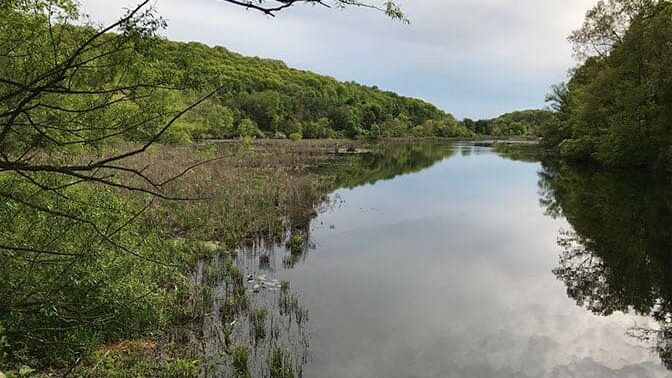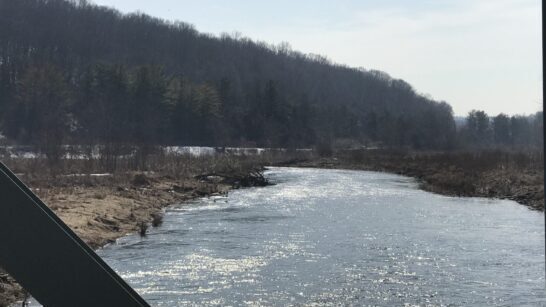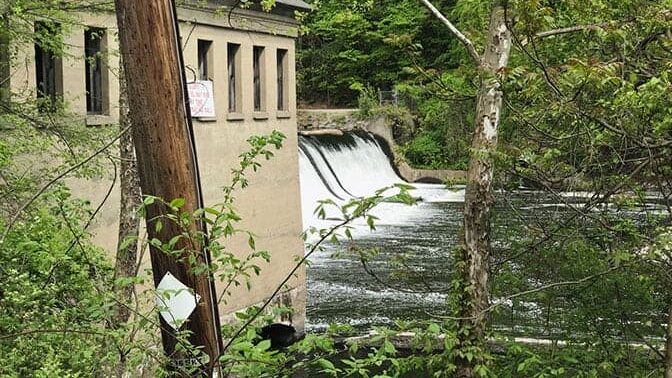Dam removal leads to rebirth of the Paulins Kill
Taken in summer 2017, here's the "lake" above the Columbia Dam on the Paulins Kill before the dam was removed. Notice how the marsh grasses are growing into what environmentalists call an impoundment, stressing the non-natural creation of the lake. PHOTO BY MEG MCGUIRE
COLUMBIA, NJ – Of the 1,700 dams in New Jersey more than five feet high, the Columbia Dam that blocked the Paulins Kill for 110 years was a priority for removal.
Beth Styler Barry, director of river restoration for the Nature Conservancy, explained in a telephone interview, the reason the dam ranked in the top 5 percent of all dams prioritized for removal on the East Coast was its proximity to the Delaware River. Because the Paulins Kill was blocked less than half a mile from the Delaware, shad trying to make their way up would be thwarted by the dam.
The dam, 18 feet high and 300 feet long, was constructed in 1909 to provide electricity for the nearby towns and for ice harvesting, common at the turn of the 20th century before electric refrigerators. The impoundment was 32 acres, not large for a lake, but sufficient to provide ice for plenty of iceboxes.
A newsletter item on the Nature Conservancy of New Jersey website said sediment accumulated behind the dam choked fish and depleted the food supply for birds and other wildlife.
The Nature Conservancy was the lead agency working on the dam removal, Styler Barry reminded the Knowlton Township Committee and guests at a recent meeting. Its partners were the New Jersey Department of Environmental Protection; New Jersey Fish and Wildlife Service; American Rivers, a nationwide non-profit; and environmental consultants Princeton Hydro. Together they created the engineering design, acquired the proper permits and raised funds for the demolition.
Before starting on the demolition, Styler Barry said the conservancy had to approach the locals who were opposed to the project, including Knowlton Township Committeeman and former long-time Mayor Frank VanHorn. VanHorn said about 70% of the locals considered the structure an important asset to their community. Many of them routinely fished the Paulins Kill in the area of the dam.
"Best fishing spot in Jersey," VanHorn said. The lake was also used for canoeing.
The one part of the project many locals did favor, VanHorn said, was connecting two trails on opposite banks of the river under the Route 46 bridge, thus eliminating the need for hikers to detour onto the highway.
VanHorn also pointed out the dam still generated electricity for about 200 homes and said when the dam was rebuilt in the 1980s the contractor found it only 3 inches off level after all those years.
The electricity generation hasn’t been lost. The Nature Conservancy worked with New Jersey Fish and Wildlife to install solar panels at the Pequest Trout Hatchery. Styler Barry said the installation is in the hands of the NJDEP so she isn’t sure when it will be complete. The Nature Conservancy designed the panels, which are to be installed over the race ponds to protect the fry from a disease spread by predatory birds. The panels are designed to generate more electricity than the dam did, according to the Nature Conservancy website.
The consortium was formed in 2014 and the first act was the removal of a small, failed dam downstream. A lane was cut in for the heavy equipment and the first cut, 30-feet wide and 5-feet deep, allowed the Paulins Kill to run free for the first time since 1909.
While VanHorn questions whether true fishermen actually fish for shad in tributaries to the Delaware, Barbara Brummer, state director of the NJ Chapter of the Nature Conservancy, wrote in the newsletter: "It is a special kind of satisfaction to know that American shad will no longer ‘bump their noses’ on the Columbia Dam when they return to spawn and that cleaner water will be entering the Delaware."
Fishing for shad will not be allowed until the species has a chance to re-establish in the Paulins Kill.
The Paulins Kill is the third largest tributary of the Delaware in New Jersey.
Styler Barry said the benefits of removal will continue to be obvious as plant seeds buried underwater for years began to sprout only days after the lake drained. In addition, bald eagles, blue herons and kingfishers as well as other wildlife returned.
"The river has not forgotten what to do," she said in the newsletter, "all we had to do was get out of its way."
Early in the project, locals were interested in keeping the historic powerhouse, Styler Barry said. The state, which has owned the dam since 1955, wasn’t interested in an expensive salvage of the old building.
While the Columbia Dam project is completed, there are still more dams that should come out, Styler Barry said.
One, the Paulina Dam, is just above Blairstown on the Paulins Kill. It’s smaller than the Columbia Dam, 12 feet high and 230 feet wide.
The Paulina Dam also produced electricity at one time. It is owned by Blairstown Township and the municipality is cooperating with eventual removal. The Nature Conservancy and partners are also considering the removal of the County Line Dam, 15 miles further up the river. It is privately owned and quite small, Styler Barry said.
Probably here to stay are the Blair Academy Dam in downtown Blairstown and the Paulinskill Lake Dam. That dam, in Fredon and Stillwater townships in Sussex County, creates a lake that is surrounded by bungalows, many of which have been converted to year-round use.
The Musconetcong Watershed Association is continuing to remove dams along that largest New Jersey tributary to the Delaware. There were many mills along the Musconetcong producing goods during the 18th and 19th centuries. Some were in bad shape when taken out, while others had survived the years well, but all blocked the passage of fish up the river.
Other tributaries in both New Jersey and Pennsylvania are still blocked by dams. Many are privately owned and the property owner’s cooperation is needed for any removal, Styler Barry said.
"There are few times when working in the natural world produces immediate results as it does with dam removal," Styler Barry said. "Most things are incremental, this is immediate change."





